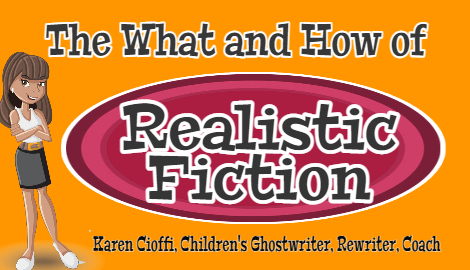I just finished rewriting a long picture book intended for the young end of middle grade. The word count is around 1200.
The story is realistic fiction, but the client had several scenes that were not realistic.
Two that jumped out are:
1. A physically disabled boy in a wheelchair with leg and arm limitations went to the park to watch a ball game with kids he had just met that day. Without an aide or family member.
2. The story’s circle of friends invented a gadget for the disabled boy to eat ice cream. They were selling their invention without parental involvement or professional advice and for a ridiculously low price.
I explained to the client that these scenarios aren’t realistic. The disabled boy depicted in the story would have an aide or guardian with him. And a minor can’t enter into a contract.
The response was that it didn’t need to be that realistic.
When writing, you must be familiar with the genre you’re writing in.
If your story is riddled with things that just wouldn’t happen in realistic fiction, the reader will catch on very quickly. This will cause the book to lose its authenticity and professionalism.
So, let’s go over the ‘what and how’ of this genre.
WHAT IS REALISTIC FICTION?
Realistic fiction is a genre that involves stories that could have actually occurred to people or animals in a believable setting.
These stories typically feature true-to-life characters, events, and places. The plot is often rooted in everyday experiences and challenges, making the characters and their circumstances relatable to the reader. The characters react similarly to real people.
KEY CHARACTERISTICS OF REALISTIC FICTION:
1. Believable Characters: The characters in realistic fiction are complex, fully developed and exhibit realistic human emotions, motives, and behaviors.
2. True-to-Life Settings: The settings are plausible and reflect real-world locations, whether they're contemporary or historical.
3. Plausible Plot: The events that occur in the story are feasible and could happen in real life. There are no fantastic or extraordinary elements.
4. Realistic Problems and Conflicts: The problems and conflicts the characters face are similar to those encountered in everyday life.
5. Authentic Dialogue: The conversations between characters sound natural and true to life, reflecting how people actually speak.
HOW TO WRITE REALISTIC FICTION
1. Develop Believable Characters:
• Character Profiles: Create detailed profiles for your characters, including their background, personality traits, strengths, weaknesses, and desires.
• Character Growth: Ensure your characters experience growth or change throughout the story. They should learn, adapt, and evolve based on their experiences.
• Motivations and Flaws: Give your characters clear motivations and realistic flaws to make them more relatable and human.
2. Create a Realistic Setting:
• Detailed Descriptions: Use vivid, sensory details to bring your setting to life. Describe the sights, sounds, smells, and textures. If you’re writing a picture book, keep in mind that words are limited.
• Research: If your story is set in a specific time or location, conduct thorough research to ensure accuracy and authenticity.
3. Construct a Plausible Plot:
• Realistic Conflicts: Develop conflicts your readers can relate to, such as family issues, social challenges, or personal dilemmas.
• Logical Progression: Ensure the plot progresses logically from one event to the next. Avoid improbable coincidences or unrealistic scenarios or outcomes.
• Resolution: Provide a satisfying resolution that feels authentic, even if it’s not a “happy ending.” The conclusion should stem naturally from the story’s events and character decisions. Keep in mind the age of the reader, though. If you’re writing for young children, the outcomes should be ‘happy.’
4. Write Authentic Dialogue:
• Natural Speech Patterns: Listen to how people speak in real life and try to mimic those patterns in your writing. You can also read traditionally published books in the genre you’re writing to see how other authors create natural dialogue.
• Subtext: Remember that real conversations often involve subtext—what characters don’t say can be as important as what they do say.
• Avoid Exposition: Don’t use dialogue solely to provide information to the reader. Keep it natural and engaging.
5. Use Realistic Themes:
• Universal Themes: Explore themes that resonate universally, such as love, loss, illness, identity, family, and personal growth.
• Depth and Nuance: Treat themes with the complexity they deserve. Avoid oversimplifying or diminishing issues or moralizing.
6. Edit and Revise:
• Feedback: Share your work with others to get feedback on the realism and relatability of your story.
• Refine: Revise your story to enhance realism, focusing on character development, plot consistency, and dialogue authenticity.
•
EXAMPLES OF REALISTIC FICTION
• "To Kill a Mockingbird" by Harper Lee explores themes of racial injustice and moral growth in the context of the American South.
• "The Fault in Our Stars" by John Green follows the lives of teenagers dealing with cancer, highlighting their struggles, relationships, and growth.
• "The Catcher in the Rye" by J.D. Salinger centers on the experiences of a disaffected teenage boy and addresses themes of identity, alienation, and loss.
SUMMING IT UP
By focusing on creating believable characters, settings, and plots, and addressing real-life issues and conflicts, writers can craft compelling and relatable realistic fiction that readers will connect with.

I’m a working children’s ghostwriter, rewriter, editor, and coach. I can help turn your story into a book you’ll be proud to be the author of, one that’s publishable and marketable.
OTHER HELP I OFFER:
HOW TO WRITE A CHILDREN’S FICTION BOOK
A DIY book to help you write your own children’s book.
PICTURE BOOK AND CHAPTER BOOK COACHING
Four to ten-week coaching programs.
WRITERS ON THE MOVE PRESS.
Self-publishing help for children’s authors.
You can contact me at: kcioffiventrice@gmail.com. Or give me a call at 347—834—6700. (Please leave a message- I’ll get back to you as soon as I can.)


1 thought on “The What and How of Realistic Fiction”